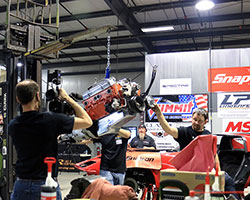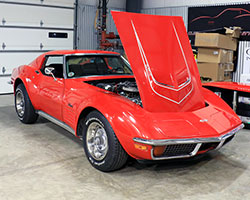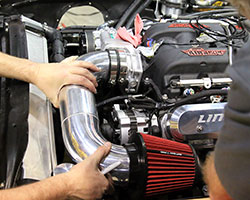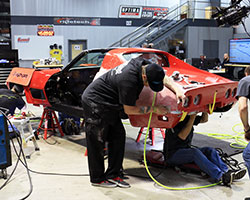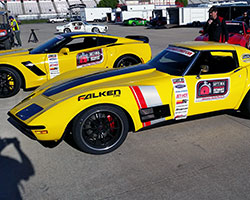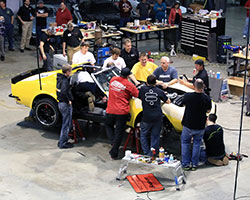Spectre Performance Supports RideTech Suspension 1972 C3 48 Hour Corvette Build
- Apr 28, 2015
Four years ago RideTech Suspension took the challenge of building a first gen Camaro in 48 hours and their overwhelming success led them to try it again with a 1972 C3 Corvette LT-1 4-speed car. According to Bret Voelkel, President of RideTech, “The original 48 Hour concept came about at the 2010 SEMA show during a discussion about there being so many parts available for early [gen] Camaros, that you could bolt one together in a parking lot in a weekend.” Additionally, when RideTech decided to take on the challenge of building a car in 48 hours, the team wanted to demonstrate that they could not only build a car quickly, but build a car that was sound. There are countless “Reality” Show car builds on television showing how the builder can transform a car in a matter of days. What is rarely shown on these reality television programs is how the car holds up to the real world and track conditions over time. RideTech’s latest project car is a 1972 C3 Corvette purchased off of eBay out of the Phoenix, Arizona area. The RideTech 48 Hour Corvette project came to them powered by an LT-1 V8 and a 4-speed manual transmission in rather nice as well as completely roadworthy condition. When asked why a C3 Corvette was chosen for the 48 Hour build Voelkel responded “Up to this point most of these cars have been restored or lightly modified, but recently there is a growing number that have been upgraded with modern drivelines and other amenities. The newer C5, C6, and now C7 Corvettes are such highly refined cars that now the C2 and C3 guys want their cars to perform that way too. We intend to show them how!”
Since it is unreasonable to expect anyone to work for 48 Hours straight the build was broken into 16 hour shifts spread out over three days. Voelkel explained, “The primary build crew will consist of three teams of three people each. One team will be working in the engine bay, one team under the car, and one team inside of the car. Each team will have one person designated as the team leader… he gets to make the decisions and will expedite any problems with components, fabrication, or tools.” Also, building the Corvette over the course of three days will enable the teams to overnight any parts they may have overlooked or did not plan on needing due to those inevitable surprises. The entire build from start to finish was streamed live online and hosted by Chad Reynolds. Viewers had the opportunity to participate in question & answer sessions as well as chances to win prizes through the RideTech Facebook page. The 48 Hour Corvette build also included major manufactures such as Lingenfelter, who was behind the LS7 install, Centerforce and Bowler Transmissions for the transmission and clutch, Kicker for the audio, Summit Racing, Baer Brakes, Spectre Performance and several others. Brett Voelkel and the RideTech 48 Hour Corvette team rolled the car into the shop at 8am Tuesday March, 10th and the countdown began. First on the to-do-list was tearing the perfectly nice 1972 C3 Corvette apart. Most of the original parts came out including the LT-1 V8 motor, seats, suspension, and more. Major take-off components were immediately listed on eBay giving viewers a chance to own a piece of the project. Once the tear down was complete the teams began working on installing the new suspension and performing bodywork. There were about 50 people at all times in the shop including those working on the car, the film crew, outside media, and representatives from the sponsoring manufacturers.
The new Lingenfelter LS7 427 CI 630 HP crate engine was installed on day two of the build, Wednesday the 11th, in the late evening. The new crate engine install was an important part of the timeline for Spectre Performance since Spectre representatives would need to wait to get started on an idea for the custom Spectre Performance LS engine swap cold air intake. Unfortunately, Wednesday also included wrapping the car, putting even more people around the build and making it hard to get inside the engine bay. It was agreed that Spectre Performance representatives and the engine bay team would focus on the Spectre Performance muscle car intake the next morning following the C&R Racing aluminum radiator install. Following the radiator install it was immediately clear that space under the hood of the 1972 C3 Corvette was at a premium. After some measurements and mockups Spectre representatives, as well as Mike Copeland and Chris Smith, came up with a design that positioned the Spectre synthetic air filter away from the radiator and offset from the engine. The location wasn’t ideal, and it was suggested that a heat shield should be fabricated to deflect heat after the 48 hours were up. After marking the Spectre Performance aluminum air intake tubes the RideTech crew cut and welded them together. An Intake Air Temperature sensor (IAT) was needed so the guys welded a bung into the tube. The RideTech crew followed up by polishing the Spectre air intake tubes so any marks made during fabrication were no longer visible. The 48 Hour Corvette build was very in depth and included a host of electronics only found in modern supercars. The RideTech crew bit off a little more than they could chew and the wiring became a serious complication as day three of the build came to an end on Thursday March, 12th. As midnight approached and the 48 hour time limit was almost up. People everywhere were waiting to see what the result would be when the clock hit midnight. Although the 48 Hour Corvette was about 90% complete, the RideTech team was unable to meet their 48 hour deadline. The build team was able to turn the engine over at midnight which gave spectators something to cheer for. The 48 Hour Corvette build was finished two days after the deadline once the wiring was complete. Following the 48 Hour Corvette’s completion, the crew took the car to the track and did some test runs with it. RideTech’s original goal was to prove the quality of their 48 Hour Corvette build the day after the build by driving it approximately 120 miles to the National Corvette Museum in Bowling Green, Kentucky, and taking the C3 Corvette on the new road course. To further demonstrate how well the 48 Hour Corvette was built, Chris Smith will drive the car in a number of events throughout the 2015 and 2016 race seasons. These events include: Goodguys autocross, Optima Ultimate Street Car events, an appearance at the 2015 SEMA Show, as well as a few other Corvette events. The RideTech 48 Hour Corvette, driven by Chris Smith, has already posted some excellent race results on the Goodguys and USCA race circuits. Since 1983 Spectre Performance has designed and offered unique, innovative, parts and components to fuel your car or truck obsession. Even if your fixation happens to be a classic muscle car with a modern powertrain, Spectre will help fuel your passion for performance. Browse all Spectre automotive products by category at SpectrePerformance.com. While you are there use the Products by Vehicle Search to find Spectre performance products specifically made for your vehicle. To find a Spectre dealer near you use the Spectre Dealer Locator. |
||||||

